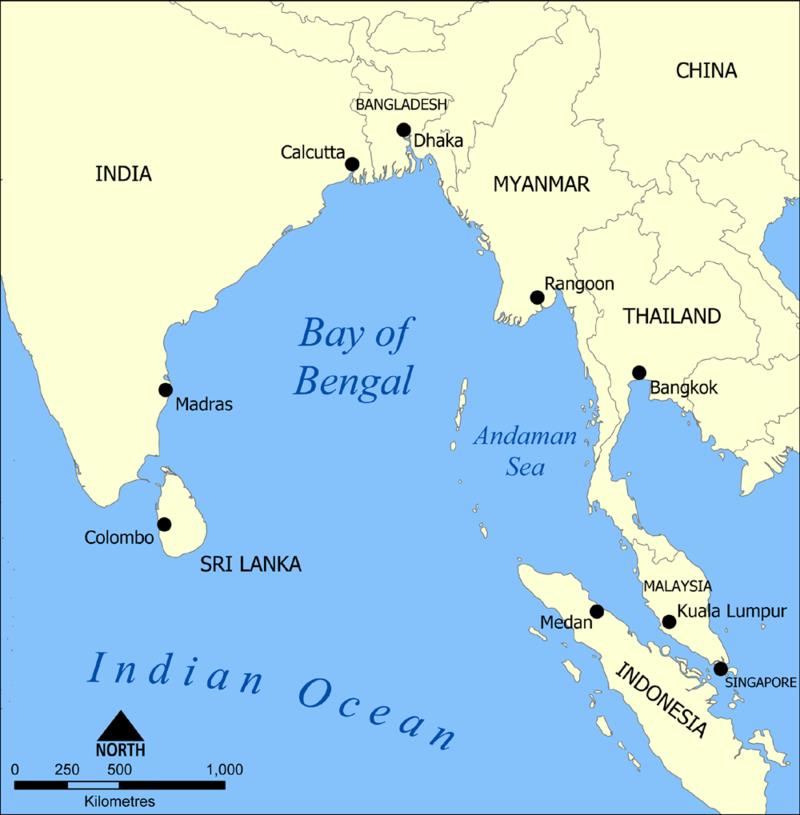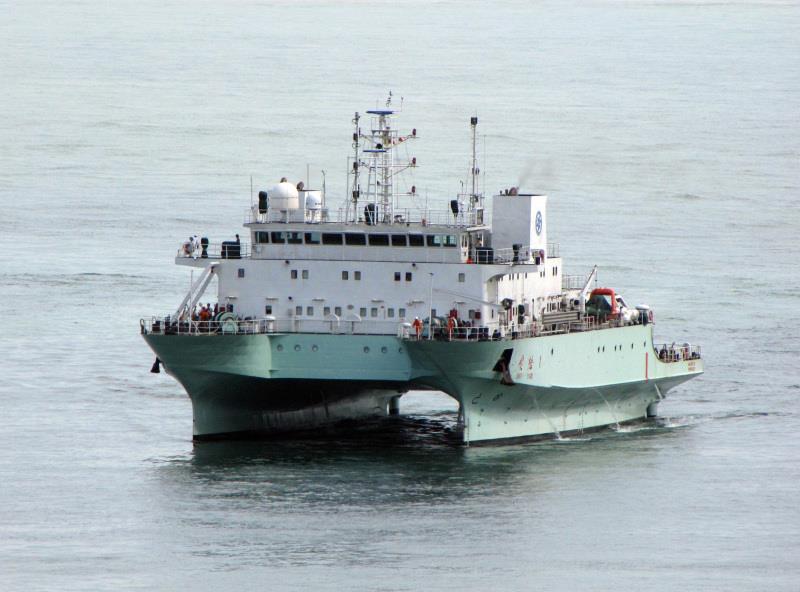
Strategic Challenges In The Bay Of Bengal
Colombo, September 17: Bangladesh's former Prime Minister Sheikh Hasina had alleged that the United States would not have“conspired” to oust her from power if she had only handed over St. Martin's island in the Bay of Bengal to it.
St. Martin's island is only 3 sq. km in area. It lies in the north eastern part of the Bay of Bengal, about 9 km south of the Cox's Bazar-Teknaf peninsula in the southernmost part of Bangladesh.
ADVERTISEMENTIt is about 8 km west of the northwest coast of Myanmar at the mouth of the Naf River. This has made it a bone of contention between Bangladesh and Myanmar. Its 10,000 inhabitants are a mix
of Bangladeshis and Rohingya infiltrators from Myanmar.
Sheikh Hasina's charge about the US demanding St's was refuted by the US. However, when Bangladesh was part of Pakistan (prior to December 1971), the Pakistan government had offered the island to the US.
Grey Zone
Be that as it may, Sheikh Hasina's allegation brought into focus the strategic importance of the Bay of Bengal (BOB). Although full-scale wars are unlikely to be fought in the BOB, it is a“grey zone” where there could be military operations below the threshold of high-intensity military conflict between the US/India on the one hand and China on the other.
The University of Texas scholar, Mohammad Rubaiyat Rahman, says in a paper published by the Centre for International Maritime Security, that in a grey zone, adversaries could impede economic exploitation or hamper safe passage. They could assert their maritime interests at the expense of other States in the grey zone. They could try to get political and economic control over the littoral states of the grey zone.
“China's ceaseless endeavour to penetrate the BOB through Bangladesh, Myanmar, and Sri Lanka makes it a grey zone for the US and India. BOB littoral states like Bangladesh and Sri Lanka have depended onChina for economic and infrastructure development. China has constructed ports, roads, pipelines, and railway tracts in these littoral states. In American eyes, these developmental activities constitute China's grey zone activities in the BOB of potential strategic value,” Rahman points out.
America fears that China is earning significant political leverage over decision-making in these countries. To the US, these projects also enhance China's military access in the region.
In the case of many littoral states of the BOB, China is a major supplier of military hardware. Bangladesh has operationalized the country's only submarine base, BNS Sheikh Hasina, constructed with Chinese financial and technical assistance.
China sold two Type 035 G Ming-class submarines to Bangladesh in 2016, and a B-variant Ming-class submarine to Myanmar in 2021. Chinese submarine crews were posted to these nations for training purposes. These deals increase China's competitiveness in the BOB grey zone, US fears.
Myanmar's airstrip extensions and construction of aviation hangers on the Great Coco Island suggests Chinese involvement and potential uses for maritime surveillance, Rahman adds.
Then, there are the Chinese oceanographic survey vessels which visit the Indian Ocean, though there are no reports of their entering the BOB as such. China is seeking a better understanding of the undersea environment in the Indian Ocean (IOR). These activities pave the way for submarine operations.
According to Rahman, the oceanographic vessel Shi Yan 1 was used in the Indian exclusive economic zone adjacent to the Andaman Nicobar Islands. The Xiang Yang Hong 06 conducted joint scientific surveys in the territorial sea of Myanmar in February 2020. The same vessel, prior to the Myanmar visit, had conducted research on the seabed of Sri Lanka's territorial sea.
Myanmar
Developments in Myanmar complicate the geo-strategic situation in the BOB for the US and India.
Relations between China and the military junta in Myanmar are very warm. But the China-backed military junta is facing widespread civil protests, armed resistance from ethnic insurgent groups, and the civil defence forces backed by the National United Government(NUG).
The NUG has close ties with the US.
Despite its links with the US and China, Bangladesh has not been able to get either the US or China to get the Myanmar political groups to agree to take back the two million Rohingya Muslims who had fled to Bangladesh from the Arakan region of Myanmar.
American was annoyed with Sheikh Hasina for refusing to join the US-sponsored anti-China QUAD group. The US had attacked her on human rights issues and sanctioned senior officers of the Bangladesh security forces.
India's Response
As a BOB power, India is naturally concerned about China's activities in the BOB and the littoral States, Rahman says.
The Indian Navy's Information Fusion Centre for the Indian Ocean Region exchanges of information with select partners in the BOB. The littoral states of Bangladesh, Sri Lanka, and Myanmar are among the partners in this security collaboration structure. The Indian Navy has deployed coastal surveillance radar systems in Bangladesh, Sri Lanka, and Myanmar.
India has purchased twelve American-made P-8I maritime patrol aircraft. The P-8Is offer not only superior surveillance and reconnaissance capabilities, but also greater speed and longer endurance, making them better anti-submarine warfare platforms.
India has also established the Baaz naval air station on Great Nicobar Island at the southern end of the Nicobar Islands, only 450 km from the Malacca Strait. In 2019, India established the Kohassa naval air station on North Andaman Island to watch“a suspected Chinese intelligence outpost on Myanmar's Coco Island.”
The Indian navy rebased a Kora-class guided-missile corvette to Port Blair, and the Indian air force established a forward base for its Su-30MKI fighters on Car Nicobar. The Indian army has test fired its Brahmos anti-ship missiles from the islands, Rahman notes.

Bay of Bengal
Andaman Islands
The Andaman and Nicobar Islands (A and N), which are part of India, are key to India's security as pointed out by former Indian Navy chief, Adm Prakash.
The A and N are only 22 miles from Myanmar.
At the southern end, the Indira Point is just 90 miles from Indonesia's Aceh province and the coast of Thailand lies 270 miles to the east. In stark contrast, Port Blair, the capital of A and N islands, is about 850 miles from Chennai and Kolkata.
Only 31 of the Andaman archipelago's 836 islands are inhabited, which means that some of them could be surreptitiously occupied and used against Indian and Western shipping, warns Adm. Prakash.
In an article in Indian Express, Adm. Prakash recalls that as early as in 1962, a Chinese submarine was sighted off the Andamans. In September 1965, after the commencement of India-Pakistan war, Pakistani President Ayub Khan sent retired Air Marshal Asghar Khan as an emissary to seek support from Indonesia.
Air Marshal Khan was taken aback when the Indonesian navy chief, Admiral Martadinata, asked him:“Don't you want us to take over the Andaman Islands? They are an extension of Sumatra and are, in any case, between East Pakistan and Indonesia. What right have the Indians to be there?”
Since then, India has upgraded the detachment in the Andaman and Nicobar islands to a joint/unified operational command - the Andaman Nicobar Command (ANC) in Port Blair. Adm. Arun Prakash recommends that the base in the Andamans maintains a three-dimensional maritime domain awareness through networked assets, including radars, aircraft, satellites and unmanned vehicles.
The command must be invested with adequate defensive and offensive firepower, as well as rapid-reaction forces with amphibious and airlift capabilities, he suggests.
US Involvement
Though the Indian Navy is strengthening itself in the Indian Ocean, it is the US Navy which needs to helm the anti-Chinese grey zone operations, Rahman says.
Through the Joint Combined Exercise Training (JCET), the Cooperation Afloat Readiness and Training (CARAT) and the Malabar Exercise, the U.S. Navy has helped regional navies support maritime security and maritime domain awareness in the BOB through exercises such as the Malabar exercise. But more needs to be done, Rahman says.
In 2013, RAND corporation recommended that the US acquire a surveillance base in the Andamans. But the US denied any such plan and added that RAND, a private body, could only make suggestions, not policy.
END

Legal Disclaimer:
MENAFN provides the
information “as is” without warranty of any kind. We do not accept
any responsibility or liability for the accuracy, content, images,
videos, licenses, completeness, legality, or reliability of the information
contained in this article. If you have any complaints or copyright
issues related to this article, kindly contact the provider above.


















Comments
No comment